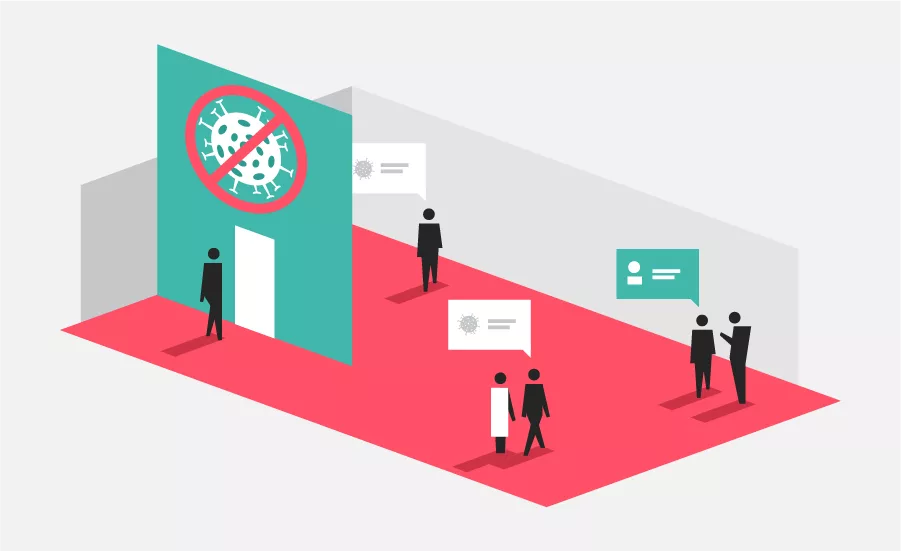Ensuring Workplace Safety for Essential Services during the Coronavirus Outbreak

Figuring out the new normal is evolving by the hour for organizations across the globe. The domino effect of the coronavirus outbreak has severely impacted every facet of our everyday life, including how we work. For many companies in industries like tech or finance, offices have temporarily shut down as remote work is becoming the standard.
However, there are also organizations whose doors must remain open. Industries that provide essential services (food manufacturing, biotech, pharmaceutical, utilities, etc.) must maintain operations in order to support society during this outbreak.
Conducting business as usual, with the added layer of maintaining workplace safety and minimizing the spread of the virus, will prove to be a challenge. On top of implementing safety processes for their employees, companies will have to carefully evaluate contractors, employees from other locations, vendors and delivery people - all of whom can be essential visitor types, yet potentially introduce risks to business continuity if their access is unmanaged.
As we saw at Facebook and more recently, at Kimberly Clark, contractors and visitors present a potential health risks to work sites if not managed carefully. The spread of the COVID-19 coronavirus has not shown signs of slowing down. As of March 18, there are over 215,000 cases worldwide, including over 8,000 in the United States.
Managing visitor access through visitor management technology - both through the invitation-first approach or the on-site approach - is the first line of defence for essential-operations organizations.
Configuring a Plan for Essential Operations
Organizations rely on visitor management systems (VMS) to improve on-site security and safety of employees and visitors who are entering their company’s facilities. According to Traction Guest’s 2020 Visitor Management industry report, 92 percent of security and facility professionals said a VMS created a safer environment.
An enterprise VMS allows organizations to streamline the visitor management process through pre-registration, visitor sign-in, ID verification and visitor identification with photo badges, watchlist creations and customizable notifications for hosts and security.
As the coronavirus outbreak started to progress, we worked with many of our customers on developing processes around workplace safety and business continuity. Organizations are rightfully concerned of the potential threat that visitors and contractors pose as far as spreading the virus to employees (and vice versa) and contaminating the premise.
VMS can be configured to mitigate these risks and help promote health and safety best practices for essential-operations organizations.
A VMS can help screen visitors to your site by:
- Pre-registering visitors - invitation email that includes site specific advisories and criteria.
- Signing-in visitors - includes thorough health and travel screening questions.
- Requiring the signing of documents - acknowledging the guest has been truthful in their health status, travel history and contact history.
- Notifying security or EHS officials - alert the proper official(s) if symptoms are noted for secondary evaluation.
But this goes beyond just putting technology in front of the problem. Organizations that maintain on-site operations during the outbreak must also create official processes and guidelines that are effective and sustainable.
For example, organizations can implement “zero touch check-in” with visitors scanning in a QR code from their phone instead of typing on an iPad. Companies can introduce an “invite first” culture, approving visits ahead of time through pre-registration and approval flows. If the visitors are determined to be high risk (ie. they have traveled within 14 days or display cold/ful-like symptoms), companies can redirect the meeting to a virtual one.
Transition to an Invite-First Culture
As unprecedented as the current situation around COVID-19 seems, the hope and the goal is that we as a society will resume some sort of normalcy at a certain point.
When social distancing recommendations (and orders) eventually get lifted as the global spread of COVID-19 hopefully gets contained, organizations will be sure to take great learnings from this experience as they return to the workplace. Organizations will take higher security precautions by re-evaluating their policies around the access and screening of their employees and guests.
As part of the roadmap for the post-coronavirus operations, we believe the workforce is heading towards an invite-first culture. This means that all people entering the premise will be properly pre-screened before they enter the facility. This is a practice that can start right now.
For those who still must commute to their workplace presently, or those who may be doing so in the near future, will want reassurance that that they are entering a safe space. Contractors and visitors will also want to know the site that they are visiting has thorough protocols around health and safety.
In order for business to resume, people will eventually need to meet. Employees with co-workers, and employees with visitors. Not just on the phone or on a video conference call, but in person, face-to-face. We still have several challenges before we reach that point again, but we’re confident that visitor management technology will be there to help keep sites safe today and down the road as we navigate through our new normal.
Looking for a reprint of this article?
From high-res PDFs to custom plaques, order your copy today!







